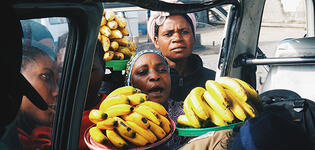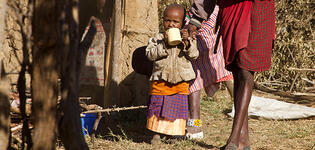Blog
Long-term research in Tanzania sheds light on the reasons rural households diversify their income
Researchers and policymakers have long asked whether rural households in Africa diversify their income to spread risk or by seizing opportunities to increase their earning potential. Long-term research in Tanzania shows that diversification is more often a choice rather than a necessity, with the potential for both wealthier and poorer households to benefit alike. Poverty traps remain, however, and policy efforts should focus on infrastructure and financial access to encourage diversification towards income generating activities.
Diversifying income sources is a common livelihood strategy for households in low-income countries. But does diversification help to escape the poverty trap? The results of our new research indicate that gaining additional income in non-farm employment is a choice of relatively well-off households rather than a mere survival strategy. Nevertheless, less well-off households have also been able to diversify their livelihoods and gain more income.
Most of the poor in Africa still rely on agriculture to safeguard their livelihoods. However, agriculture has become increasingly insecure due to the unpredictability of the weather, drought, bush fires, incidence of disease and pest infestations. Inequality and productivity differences between rural and urban areas are on the rise and there is an increased pressure for people to migrate into cities. For example, Dar es Salaam is projected to reach megacity status of 10 million inhabitants before 2030.
Not everybody is willing or able to move to the cities in the quest of improving their livelihoods. Therefore, it is of crucial policy importance to decrease the risks, improve the equality of opportunities and lower the productivity differences between rural and urban areas. Safeguarding sustainable livelihoods for those remaining in rural areas is essential. Finding out how welfare enhancing patterns can be established and sustained in the long run as well as what drives rural livelihood diversification in developing countries matters to policy-makers in developing countries.
Income diversification as choice or necessity?
Diversifying income sources is a popular livelihood strategy for households in low-income countries. Having several sources of income can help increase total earnings and spread risk. However, the research on this topic remains inconclusive, as some studies suggest that poorer households in some areas tend to diversify too much for their own good and in other areas too little.
Previous research from the Global South has sought to reveal whether livelihood diversification is a means of survival of relatively poor households or a means of accumulation by relatively better off households. If poor households diversify out of necessity by moving into higher return, yet higher risk-livelihoods, their long-term survival strategy is more uncertain. In this case the policy priority should be to reduce the risk of opting for high return choices, for example support for investments in new productive sectors and education. Alternatively, if diversification is an accumulation driven strategy, mostly undertaken by wealthy households due to high entry costs, emphasis should be placed on public investments in infrastructure, along with the removal of barriers to access to credit and engagement in high value activities.
Existing literature has not only failed to reach a consensus on the drivers of income diversification but has also abstained from identifying potential reversals of welfare gains from livelihood diversification over the long run.
Long-term research in Tanzania shows the wealthier diversify more
We investigated the livelihood diversification behaviour of households in the Kagera region in Tanzania, first during years 1991-94, and then compared those to a point in time ten years later in 2004. Having a possibility to use this sort of long-term data, where the same individuals are followed over a decade is rare in the context of Africa.
Firstly, we find that both rural and urban households were able to diversify their income sources. Moreover, people in the wealthier half of the population diversify more than their poorer counterparts. The urban-rural gap between levels of income diversification has decreased over time, and more diversification occurs in both urban and rural areas. However, the urban-rural productivity gap still remains large.
Second, livelihood diversification into non-farm employment in rural areas appears to be more a result of an opportunity to accumulate income than a mere survival strategy. Already in the 1990s and later in the 2000s, wealthier households were in a better position to diversify their incomes than relatively poorer households. However, the situation of the poorest households who diversified improved as well, and households who were diversifying their income sources witnessed a gradual shift towards better livelihoods. The observed key driver of welfare among the poor was entry into off-farm self-employment.
Improvements in infrastructure and agricultural productivity are needed
Importantly, gaining access to public transportation enhanced livelihood diversification, while access to electricity, post and telecommunications, public transport and health facilities boosted household incomes. In sum, infrastructural improvements supported diversification and growth of household income.
These findings question the pessimistic view whereby household livelihood diversification in Africa is seen as a symptom of a failing agricultural sector. Instead, livelihood diversification turns out to be a matter of choice rather than sheer necessity, with a potential of benefitting wealthy and poor households alike.
However, one should not ignore the potential of poverty traps preventing relatively poorer households from transitioning to high income generation activities. Policy effort, particularly in the form of investments in infrastructure and easier access to financial institutions and rural markets, should thus prioritise relatively poor households with the aim of pulling them out of the trap. Stronger efforts to improve agricultural productivity are also essential for improving the welfare of rural households.
This post was first published on the blog Africa at LSE hosted by the Firoz Lalji Institute for Africa. View the original post here.
See also a related Policy Brief.
The views expressed in this piece are those of the author(s), and do not necessarily reflect the views of the Institute or the United Nations University, nor the programme/project donors.
 Join the network
Join the network






